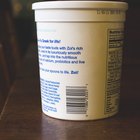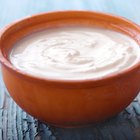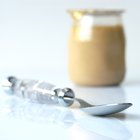samael334/iStock/GettyImages
Making yogurt at home gives you the freedom to experiment with flavors, textures and additives to find the exact combination that you like best. However, like any fermented food, homemade yogurt can sometimes fail. If your yogurt fails to thicken, the most likely cause is lack of fermentation.
Tweak Heat and Time
Fermentation, which causes yogurt to thicken, happens best in a warm environment. If your kitchen got a bit cool while the yogurt sat, fermentation may have slowed down. It hasn't stopped, but you may need to give it more time to thicken. Place the yogurt in a warm location to speed up the process. Your oven is a good place to let the yogurt sit overnight. The pilot light will add just enough heat to keep fermentation going at a reasonable pace. Keep in mind that the longer you let the yogurt ferment, the tangier the flavor will be. If you've let the yogurt ferment and it is still thinner than you'd like, put it in the refrigerator. As the yogurt cools, it will thicken.
Go Greek
If you are happy with the level of fermentation of your yogurt but would like the texture to be thicker, strain it through several layers of cheesecloth. This technique will give you a thick Greek-style yogurt. You can set up this method by placing the cheesecloth on top of a large bowl and securing it around the bowl's edges with a strong rubber band. Loosen the cheesecloth if needed and scoop yogurt into the cloth, letting it drain in the refrigerator for at least an hour or until it has achieved the consistency you desire.
Add a Thickener
Thickeners, such as nonfat milk powder and powdered gelatin, will increase the viscosity of your yogurt. Using thickeners works best for yogurt that will become part of another dish, such as a cooked sauce. The added thickeners will not be noticeable after cooking but will stand out if you eat the yogurt on its own. If you want to turn your yogurt into a dessert and don't mind a slight tang to the final product, combining thin yogurt with pudding mix can yield a rich, creamy treat.
Restart Fermentation
As a last resort, you can restart fermentation if your yogurt completely failed to thicken. Reheat the yogurt, add another dose of starter, and let it sit in a warm place overnight. If you decide to try this method, consider starting a new batch of yogurt with fresh milk that has not been ultra-pasteurized, in case your choice of milk was what prevented your first batch of yogurt from thickening.
Related Articles

Can You Repair Runny Yogurt?

How to Mix Yogurt With Unflavored ...

Cooking Yogurt Without Curdling It

Can You Bake Greek Yogurt?

How to Freeze Greek Yogurt

Cooking Yogurt Without Curdling It

How Can I Tell If Yogurt Has Curdled?

How to Substitute Yogurt for Milk in ...

Kefir Substitute

How to Sweeten Plain Yogurt

How to Fix Grainy Whipped Ganache

Can You Substitute Yogurt for Milk in ...

What is Healthier: Greek Yogurt or ...

What Happens When You Heat Up Greek ...

Instructions for the Euro Cuisine ...

How to Freeze Yogurt Sauce

Why Does Greek Yogurt Have More Protein ...

What Is "Cultured Cream"?

How to Make Penne Vodka With No Heavy ...

A Substitute for Sour Cream in Chicken ...
References
Writer Bio
Tricia Ballad is a writer, author and project geek. She has written several books including two novels, teaches classes on goal setting and project planning for writers, and loves to cook in her spare time. She is living proof that you can earn a living with a degree in creative writing.